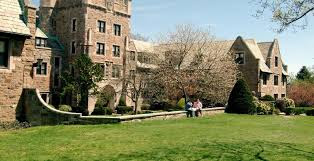Tuesday, November 10, 2015
College of New Rochelle
The College of New Rochelle (CNR) is a private Catholic college with its main campus located in New Rochelle, New York. The College of St. Angela was founded by the Order of the Ursulines as the first Catholic women's college in New York state in 1904, a time when women were generally excluded from higher education. The name was changed to The College of New Rochelle in 1910. Building on its original commitment to women, the college reaches out to those who have not previously had access to higher education. It places particular emphasis on the concept of lifelong learning. The undergraduate program remains women-only but the nursing program, graduate school and adult learners program are now open to men.
The main campus is located in New Rochelle, a suburban Westchester city about 16 miles (26 km) north of Manhattan. In 1896, the college's founder, Mother Irene Gill, traveled to New Rochelle to explore the possibility of establishing a seminary there for young women. It was during this trip that she came across Leland Castle, an 1850s gothic revival structure and former vacation home of wealthy New York hotelier Simeon Leland. The castle was purchased in 1897 and became the first structure of the College. It has since been designated a National Historic Site. The castle is part of the campus quadrangle and currently houses the "Castle Gallery". The college's art collections include a Museum Set of 75 photographs by Ansel Adams"the campus consists of 20 main buildings including a $28MM athletic, recreational and educational complex called The Wellness Center (completed in 2008), including an NCAA competition-sized swimming pool, basketball court, fitness center, indoor running track, yoga studio, roof garden and meditation garden, and volleyball court; The Mooney Center with computer and photography labs, TV production studio and the Debra and Russel Taylor Institute for Entrepreneurial Studies; the 200,000-volume Mother Irene Gill Memorial Library; the Student Campus Center; the Rogick Life Sciences Building with many laboratories; four residence halls; and the Learning Center for Nursing.
The first mention of sports at CNR is in the St. Angela’s Quarterly in 1905. A coach was hired to organize a basketball team. By 1908, annual inter-class athletic meets began between the "odds" and "evens" (year of graduation). The meets became a focus of inter-class spirit and competition—often reaching a fevered pitch. Each class had its own colors, banners, and songs which were brought out for the meet. Ingenious ways and places of getting the class banner to the highest point on campus put lives in peril as students scaled trees, sneaked up to the Castle towers, or climbed onto roofs to place the class banner. Held in the fall and spring, the meets initially involved gymnastic drills as well as basketball. Later, track and field competitions were held and awards were given. The meets continued until the early 1940s. Intramural sports were popular—basketball, volleyball, golf, hockey, tennis, and riding. In 1916, CNR began playing basketball with other college teams.
In less than 30 years, the growing College needed a much larger and more modern gymnasium than the gym in Chidwick. In 1932, at the height of the Depression, the ultra-modern Art Deco Sports Building was completed—with a pool, gymnasium, social rooms, equipment, and exercise rooms. The Athletic Association was open to anyone interested in sports, as a team member or supporter. Dues paid for some new equipment, parties, prizes, and speakers. In later years, a full CNR scholarship was offered every four years, fundraised by the Athletic Association through sponsored games and dances.sports lost some of their appeal during the politically-turbulent late 1960s-1970s, but the annual Swimphony/Landphony water and land ballet competition begun when the pool was opened continued to spark class spirit and inter-class competition into the 1990s. Exercise equipment was added in the 1970s, and the pool was often opened in the summer to day camps and residents of Residence Park.
The College of New Rochelle joined the National Collegiate Athletic Association during the mid-1980s. CNR’s basketball team took the name "Blue Angels" and won a number of local championships, a state championship and a NCAA Tournament bid, losing in the Championship Game.the College also elevated the sports of volleyball, swimming, tennis, and softball to NCAA status. CNR athletic teams have produced many successful team and individual records during their NCAA tenure.today, the "Blue Angels" remain an NCAA Division III Member and compete locally in the Hudson Valley Women’s Athletic Conference and the New York State Women’s Collegiate Athletic Association. They have continued to place in the top echelon of the HVWAC, with the Volleyball Team winning the Championship.
Labels:
College
Subscribe to:
Post Comments (Atom)


No comments:
Post a Comment